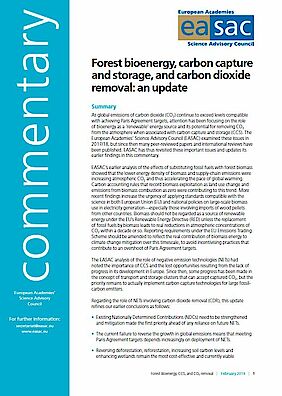Current Projects
Forest Bioenergy and Negative Emissions Update
During 2018, the EU’s Renewable Energy Directive (RED) has been revised, and the EU has also envisaged that carbon dioxide removal (CDR) may be deployed post-2040. EASAC contributed to debate through its analyses of the net climate impacts of forest bioenergy use (EASAC Report 32 and 2018 statement on carbon neutrality], and the potential for CDR through the application of negative emission technologies (NET) (EASAC Report 35). Since these reports were published, scientific papers have continued to emerge, and analyses have been completed by the IPCC and other national academies, so we decided to update our earlier analyses in the light of recent increases in scientific knowledge.
The Commentary was released in February 2019 and, among its conclusions were:
- More recent findings increase the urgency of applying standards compatible with the science in both European Union (EU) and national policies on largescale biomass use in electricity generation—especially those involving imports of wood pellets from other countries.
- Biomass should not be regarded as a source of renewable energy under the EU’s Renewable Energy Directive (RED) unless the replacement of fossil fuels by biomass leads to real reductions in atmospheric concentrations of CO2 within a decade or so.
- The priority for carbon capture and storage (CCS) remains to implement carbon capture technologies for large fossilcarbon emitters.
- Regarding the role of negative emission technologies (NETs), the current failure to reverse the growth in global emissions means that meeting Paris Agreement targets depends increasingly on deployment of NETs.
- Reversing deforestation, reforestation, increasing soil carbon levels and enhancing wetlands remain the most costeffective and currently viable means of removing carbon dioxide from the atmosphere.
- The role of bioenergy with carbon capture and storage (BECCS) remains associated with substantial risks and uncertainties, both over its environmental impact and ability to achieve net removal of CO2 from the atmosphere. The large negative emissions capability given to BECCS in climate scenarios limiting warming to 1.5°C or 2°C is not supported by recent analyses, and policymakers should avoid early decisions favouring a single technology such as BECCS.






























